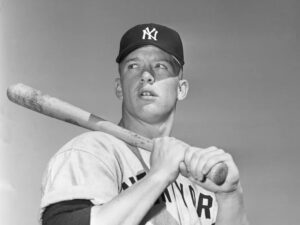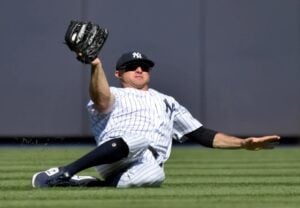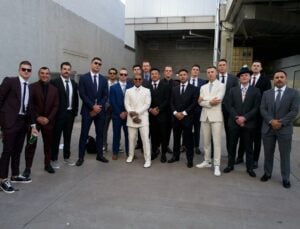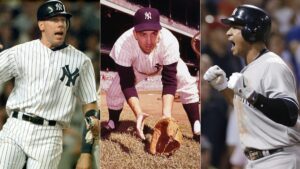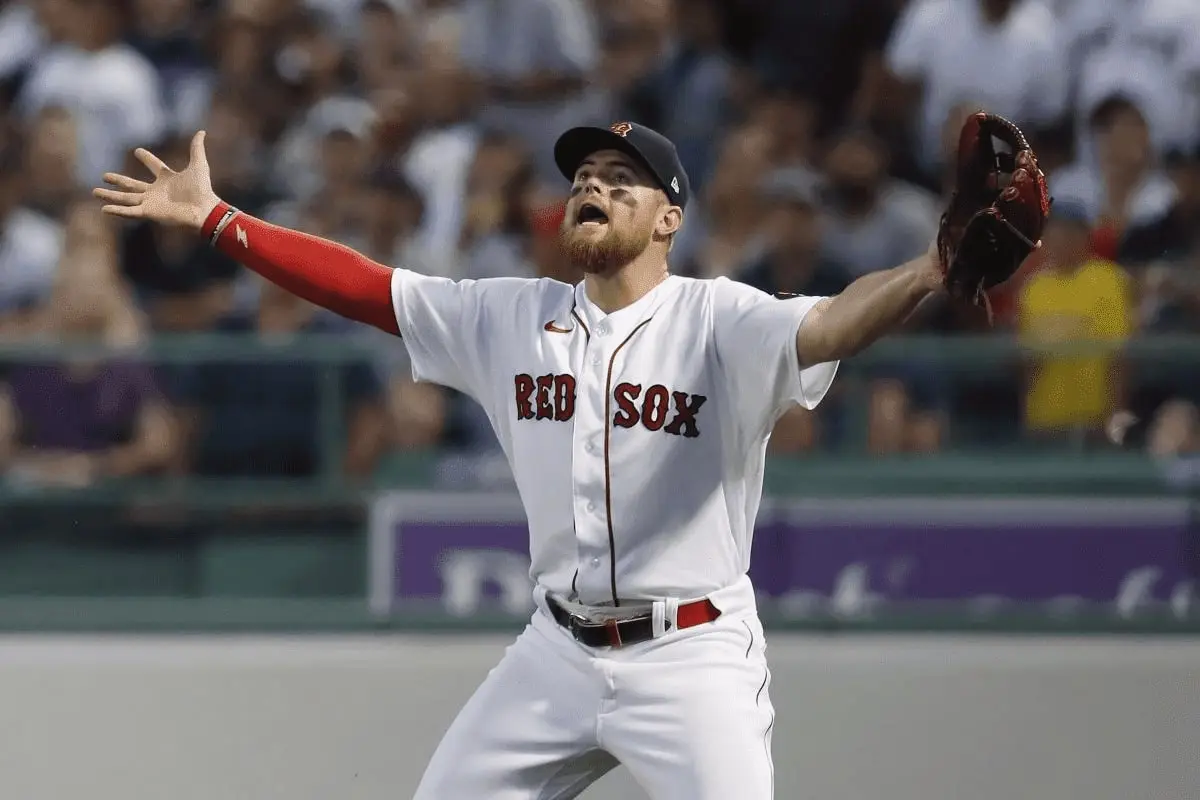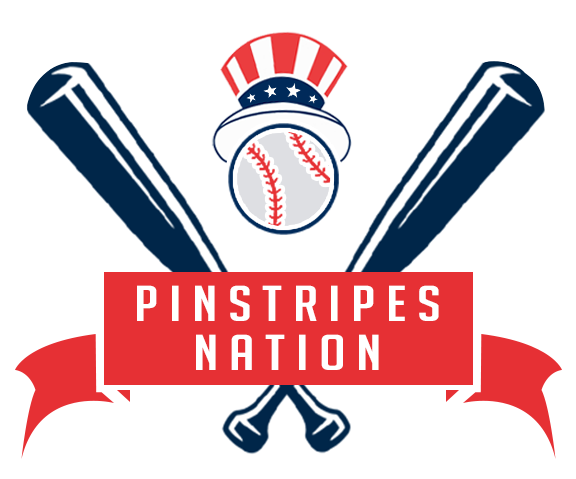Top 5 worst teams in New York Yankees history

Joe Najarian
More Stories By Joe Najarian
- Mother’s Day: How Anthony Volpe’s mom molded him into a Yankee phenom
- 470-Foot Bomb: Aaron Judge sets career record during Yankees-Red Sox clash
- Giancarlo Stanton to rejoin Yankees for Phillies series opener on Monday
- Yankees’ top prospect Jasson Dominguez nears return after oblique injury
- Rich Hill draws Yankees’ attention for midseason signing
- February 16, 2024
- 6:15 am
- No Comments
Table of Contents
The 2023 New York Yankees team wasn’t nearly as bad as these five teams.
Last season’s New York Yankees have a legitimate case for being the most disappointing team in franchise history. A team that had aspirations of winning the World Series instead ended with them missing the playoffs entirely, and just barely managing to finish over .500; they wouldn’t clinch a winning season until their penultimate game.
The 2023 Yankees were outscored by 25 runs on the year and featured a shockingly weak lineup, with key hitters either getting injured (most notably Aaron Judge) or severely underachieving (DJ LeMahieu and Giancarlo Stanton, among others). The pitching staff, despite featuring a Cy Young-winning season from Gerrit Cole, was plagued by inconsistency in both the rotation and the bullpen, with Luis Severino and Carlos Rodon having particularly abysmal seasons. The winning record is deceptive; this was a bad baseball team.
But are they the worst Yankee team ever? Not even remotely.
The Yankees aren’t immune to having teams that were straight-up awful, and even had four seasons in their history where they finished dead last in the American League. Twice in their history, the Yankees lost 100 games (although they weren’t even called the Yankees during those seasons).
As such, here is a list of the five worst seasons in Yankees history. This list won’t solely adhere to winning percentage or total losses, as it will also account for off-field issues and the overall environment of baseball, in addition to how bad they were compared to the rest of the league statistically. This makes it possible for a team with a higher winning percentage to be worse than a team with a lower one.
The 2023 team was tough to watch, but they aren’t nearly as bad as these five teams.
#5. 1925 New York Yankees (69-85, .448 winning percentage)
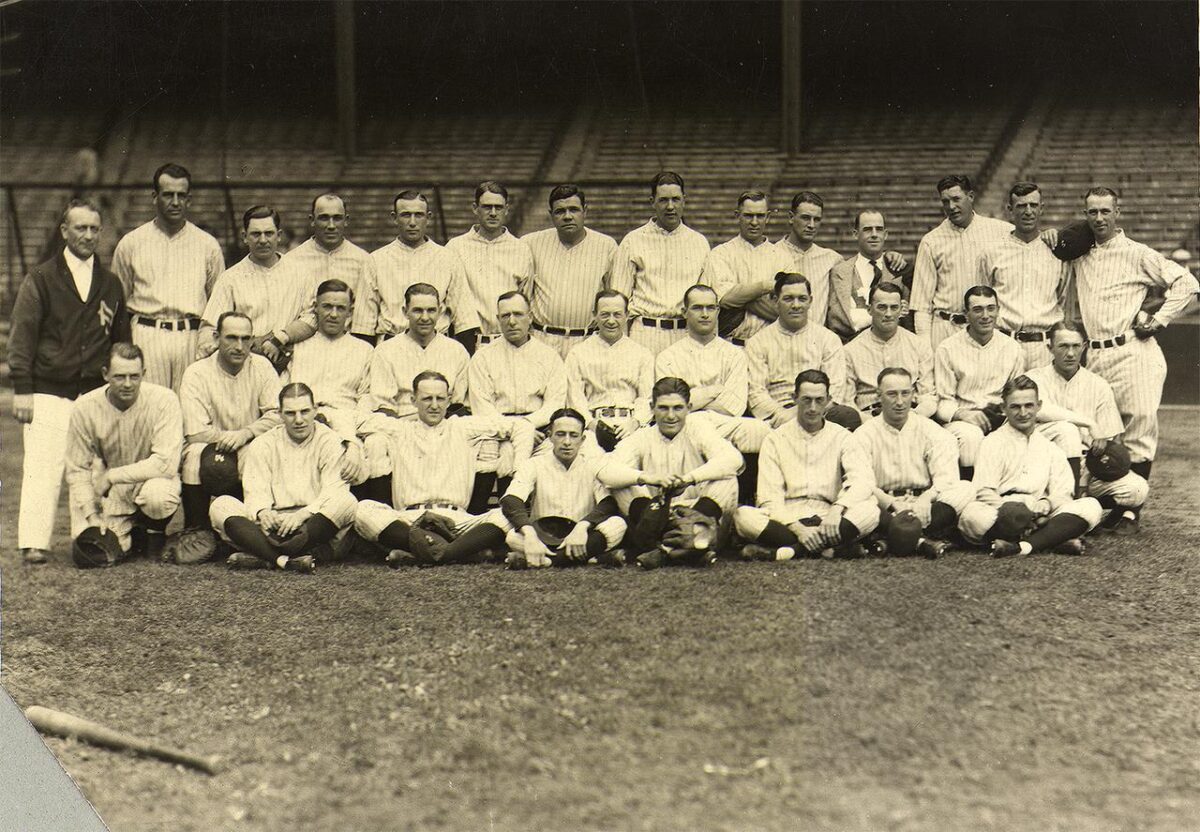
It may be surprising to see a Yankee team with Babe Ruth and Lou Gehrig on the roster appear on this list, but the 1925 Yankees found ways to lose with two of the greatest players of all time.
In all fairness, Ruth had an off year by his lofty standards, mainly because he missed a significant chunk of the season. All the binging on hot dogs and beer had caught up to him, and he fell victim to the “Bellyache Heard ‘Round the World”. Playing in just 98 of 154 games, Ruth’s overall numbers were respectable, with a .290/.393/.543 slash line, 25 home runs, and a 132 wRC+. However, all of these stats were far below his career averages, and he subsequently posted his lowest WAR as a Yankee (3.5 on both FanGraphs and Baseball Reference) while recording more strikeouts than walks for the only time in pinstripes.
As for Gehrig, he also had a respectable year by slashing .295/.365/.531 with 20 homers and a 120 wRC+. However, this was his first full season, having replaced Wally Pipp at first base, so he hadn’t morphed into a Hall of Famer yet.
Even with a less effective Ruth and Gehrig, the offense should still be great. However, the lineup was the biggest weakness of the 1925 Yankees.
Outside of the dynamic duo, the only other players to post an OPS+ over 100 were Bob Meusel, Earle Combs (another Hall of Famer) and backup outfielder Ben Paschal. The rest of the regular lineup had an OPS+ no higher than Joe Dugan’s 76. Shortstop Paul “Pee-Wee” Wanninger deserves special recognition for a 43 OPS+ and a .256 on-base percentage, in what was his only full season in the majors.
As a whole, the 1925 Yankees lineup scored just 706 runs, had a bWAR of 16.4, an OPS+ of 90 (96 when not including pitchers), and a .336 on-base percentage, all ranking as the second lowest in the AL. Such an anemic offense would undermine a somewhat decent pitching staff; Hall of Famer Herb Pennock felt the sting the most, with a 2.96 ERA and 2.87 FIP but just a 16-17 record to show for it. Meanwhile, Sad Sam Jones lost 21 games, although a 4.63 ERA didn’t exactly do him any favors.
Ultimately, the 1925 Yankees finished in 7th place, 30 games behind the pennant-winning Washington Senators. Fortunately, much better times laid ahead for the team, as they would win the AL Pennant in each of the next three years and wouldn’t post another losing season until 1965.
Which, speaking of…
#4. 1966 New York Yankees (70-89, .440 winning percentage)
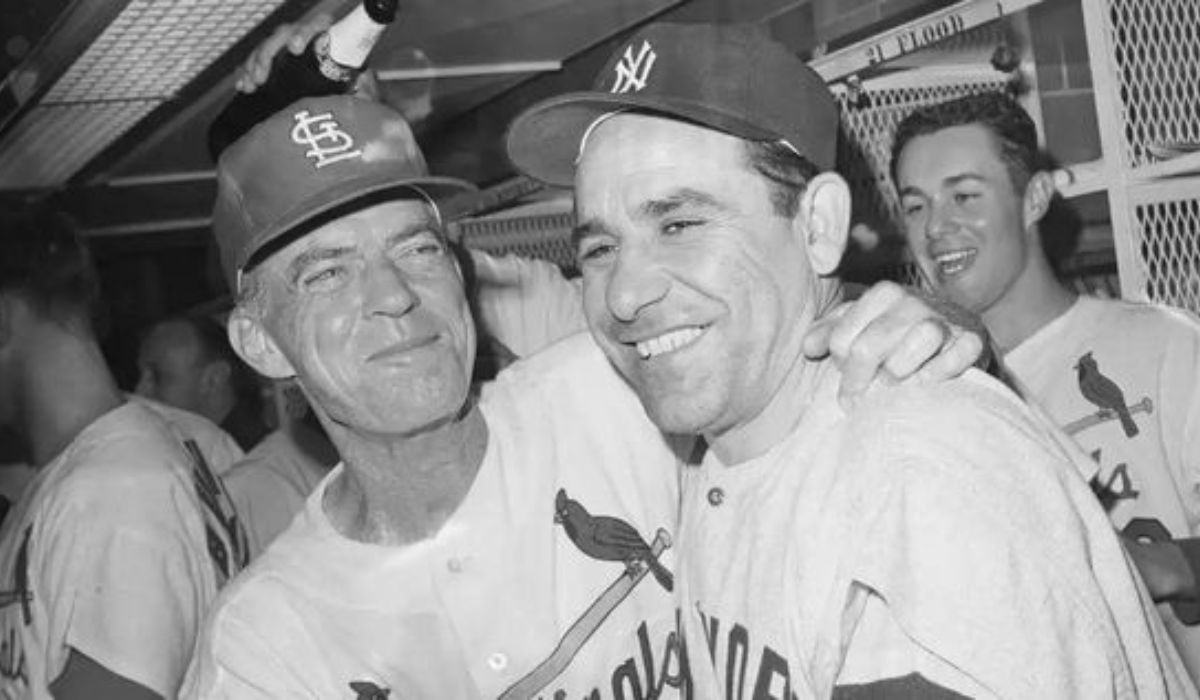
The 1965 season was the Yankees’ first losing season in 40 years, but things got even worse the following year.
In terms of statistics, the 1966 Yankees didn’t look like a last-place team. They were outscored by just one run on the season, 611-612. Five players in the regular lineup had an OPS+ of 100 or higher (albeit during a time where pitching was stronger than ever in the live-ball era). The team ranked in the middle of the pack in both runs scored and runs allowed.
But the team was the equivalent of a Fabergé egg; looking at a roster with Mickey Mantle, Roger Maris, Elston Howard, Bobby Murcer, Whitey Ford, and Mel Stottlemyre would give the impression of a good baseball team. But then someone chucks that egg against a wall, and then there’s nothing: just a hollow shell.
The 1966 Yankees were littered with aging veterans playing for a disgruntled manager in Johnny Keane. Mantle was in the middle of a steady decline; although he had a good season (.288/.389/.538 slash line, .927 OPS, 170 OPS+, and 23 homers), he played in just 108 games and had so many nagging injuries that simply swinging a bat was agonizing for him. Ford’s arm was all but dead and was unable to even go five innings regularly anymore; he was moved to the bullpen, but could only pitch in 22 games. Maris was still dealing with the effects of a broken bone in his right hand and hit just .233 and a mere 13 homers (just five years after famously hitting 61). Howard, who was an All-Star every year from 1957 to 1965, was 37 years old and could only muster a .356 slugging percentage and .673 OPS. Finally, light-hitting second baseman Bobby Richardson had an abysmal .280 on-base percentage and .330 slugging percentage before calling it a career after the season.
There were some younger players like Murcer, Stottlemyre, Tom Tresh, Joe Pepitone, Roy White, and Fritz Peterson, but it simply wasn’t enough. Murcer, who was a 20-year-old prospect at the time, wasn’t ready for the big leagues and struggled immensely; he hit just .174/.219/.217 in 21 games before being sent down to the minors for the rest of the year. Stottlemyre would have the worst season of his otherwise successful career, going 12-20 with a career-worst 3.80 ERA; the ERA looks much worse when accounting for the pitching dominance of the 1960s, resulting in a poor adjusted ERA of 87. Tresh played in 151 games as a utility player, and hit 27 homers with a team-leading 5.4 bWAR, but batted only .233. Pepitone hit 31 homers and won a Gold Glove at first base, but his plate discipline was nonexistent, resulting in an abysmal .290 on-base percentage; additionally, his penchant for hard living (similar to Mantle) would undermine what was thought to be a promising career. White would eventually become a mainstay of the Yankees in the 1970s, but he struggled with a .225/.308/.345 slash line in his age-22 season. Finally, Peterson went 12-11 with a 3.31 ERA, but he’s best known for swapping wives with Mike Kekich than for anything he’s done on the diamond.
This hot mess was over before it started. Losing 16 of their first 20 games resulted in the firing of the unpopular Keane; general manager Ralph Houk would take over as field manager, but it would be to no avail. With the team as the equivalent of a retirement home with no reinforcements from the minor leagues, they ultimately finished dead last in the American League. They hadn’t finished in the basement since 1912.
As for one final kick in the teeth, on September 22, Yankee Stadium was the equivalent of a mausoleum, with just 413 fans in attendance. When TV play-by-play announcer Red Barber commented about it and insisted on having the camera pan across the empty stadium, he was promptly fired by team management.
The 1966 Yankees may not have been the worst statistical team the Yankees have fielded, but it was symbolic for marking the death of a sports empire that wouldn’t resurrect until 10 years later.
The next three teams, though, are much worse.
#3. 1908 New York Highlanders (51-103, .331 winning percentage)
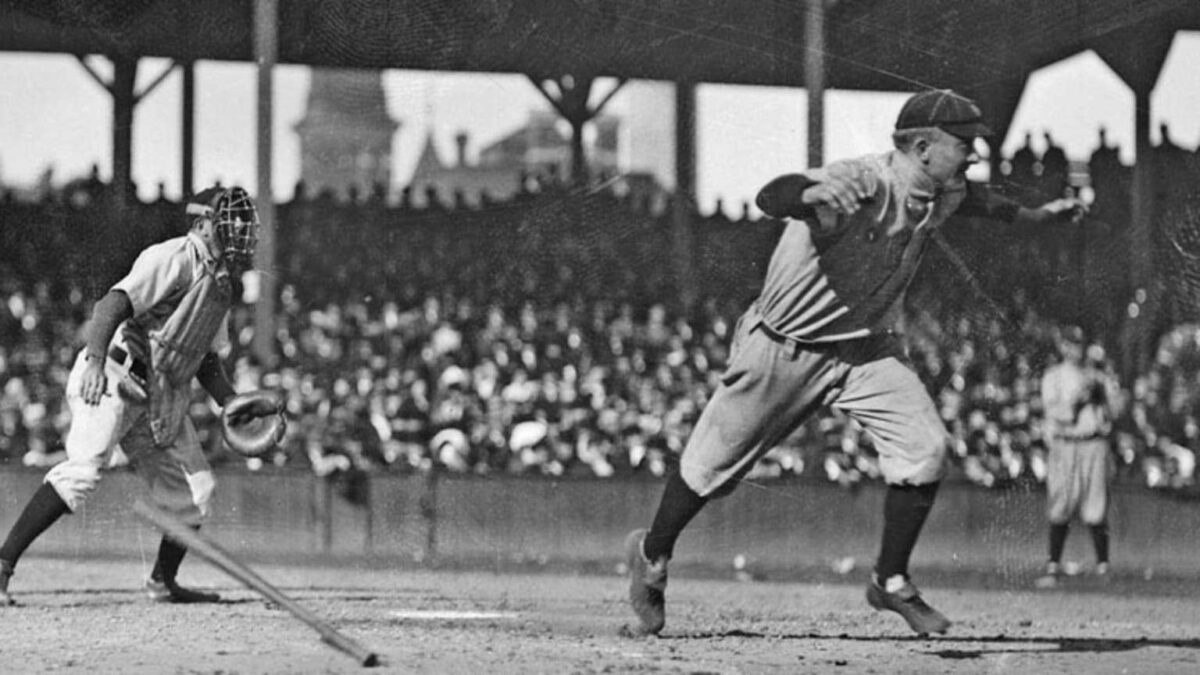
For two of the three worst teams in Yankees history, they weren’t even called the New York Yankees. Before the 1913 season, they were the New York Highlanders, playing at Hilltop Park in Manhattan.
Both Yankee teams that lost 100+ games were during the Highlanders era. The 1908 team was the first of those two, and their 103 losses remain the club record.
This team’s lineup was so bad that it made the 2023 lineup (without Aaron Judge) look like 1927 Murderer’s Row. The 1908 lineup scored just 459 runs, totaled an OPS of .575 (as a team), and nobody on the roster had a slugging percentage above .400. The team had a slash line of .242/.292/.299 when excluding pitchers.
Outfielder Charlie Hemphill was the only hitter on the roster to have a remotely respectable season, with a .297 batting average, .374 on-base percentage, 42 stolen bases, and a 3.8 bWAR; however, his power was nonexistent even by dead-ball era standards, as only 21 of his 150 hits went for extra bases, with none of them being home runs.
As for the pitching, they had a team ERA of 3.16. That sounds respectable, especially in today’s era… until you realize this wasn’t just the dead-ball era, but the nadir of the dead-ball era. Pitching was so dominant in 1908 that the American League average ERA was a 2.39 mark. (It was even lower in the National League, at 2.35.) This meant that the Highlanders actually had, by far, the worst pitching staff in the league, with an ERA+ of 78. The next highest ERA was a 2.56 mark by the Philadelphia Athletics. Ultimately, the pitching staff allowed 713 runs, and had a pair of 20-game losers in Jack Chesbro and Joe Lake; Lake was especially awful with a 9-22 record and -1.8 bWAR, while fourth starter Bill Hogg went 4-16 with only 72 strikeouts against 63 walks.
Languishing at 24-32 on June 24, future Hall of Fame manager Clark Griffith was fired. His replacement, Kid Elberfeld, led the team to a 27-71 finish. The managerial change clearly didn’t jump-start the offense; from August 28 to September 7, they scored a meager 16 runs in 14 games and were shut out six times, including three consecutive shutouts at the hands of the legendary Walter Johnson.
Don’t forget about off-field issues either; first baseman Hal Chase left the team in September due to his refusal to play for Elberfeld. (We’ll talk about Chase soon enough, as he was also on the 1912 team.)
In the end, the Highlanders finished eighth (last), 39½ games out of first and 17 games out of seventh. The .331 winning percentage is still the second worst in team history.
And yet, they’re still not in the top two.
#2. 1990 New York Yankees (67-95, .414 winning percentage)
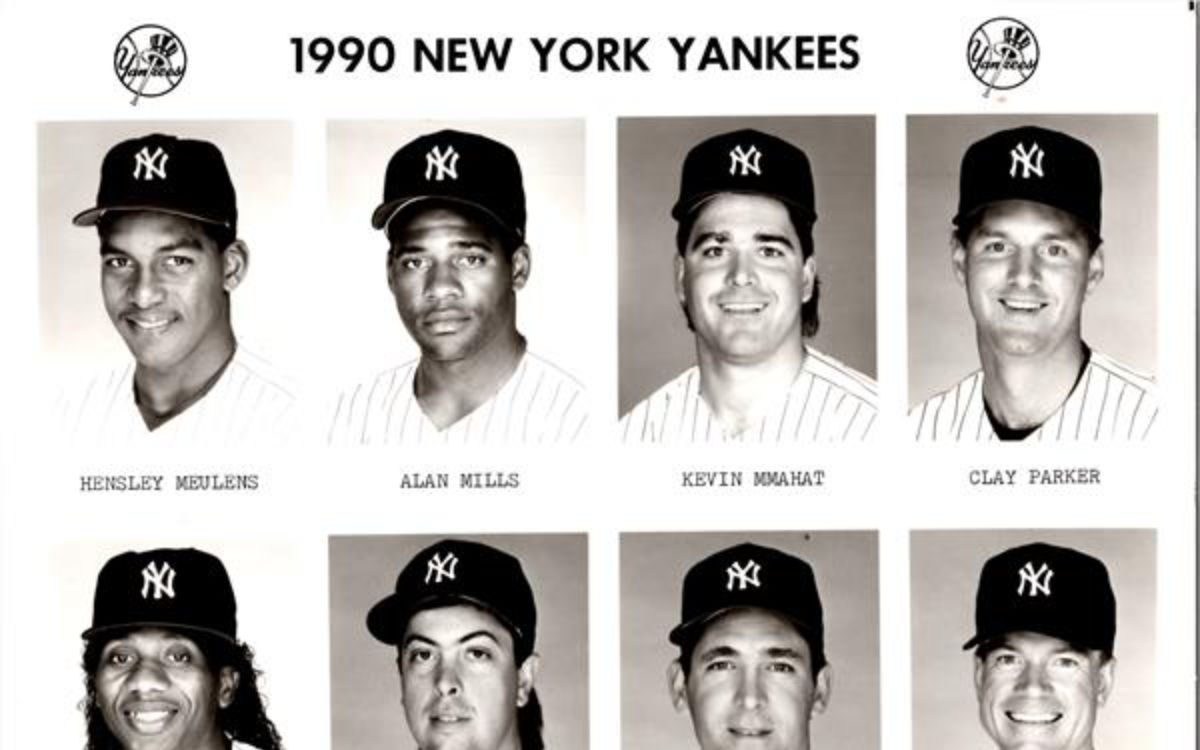
For many who grew up with the Don Mattingly-led Yankees of the 1980s (including my parents), they referred to this time as “the Dark Ages” due to the team’s inability to make the playoffs.
Ironically, the Yankees had the most regular season wins during that decade, and had the wild card existed, they would have made the playoffs in 1985 and 1986, both of which saw Mattingly place in the top two in MVP voting (winning in 1985).
It wasn’t until the end of the 1980s and the early 1990s when the Yankees sank to the bottom of the standings. But the four-year stretch from 1989 to 1992 was an absolutely miserable time to be a Yankee fan. The nadir was 1990, which saw the team finish not only in last place in the AL East, but also with the worst record in the American League and the second-worst in all of baseball (only the Atlanta Braves were worse, at 65-97, but they would win the NL Pennant the very next year).
Mattingly had the worst season of his career, and also missed 60 games due to his ailing back. After hitting no lower than .303 from 1984-1989, his average plummeted to .256, while hitting just five home runs and submitting a career-low .643 OPS. A 72 wRC+ and -0.2 fWAR was the rotten cherry on top of the shockingly poor season. Sadly, Mattingly would never be the same hitter as he was in his prime because of his back injuries.
Unfortunately, it wasn’t just Mattingly who failed to produce. The Yankees had only three particularly strong hitters in 1990, those being Roberto Kelly, Jesse Barfield, and Kevin Maas. Kelly was the team’s most valuable player, posting a 5.5 bWAR and 5.4 fWAR while playing in all 162 games; he stole 42 bases while hitting 32 doubles and 15 home runs. However, his wRC+ was only slightly above average at 106; he drew only 33 walks while striking out 148 times. Barfield hit 25 home runs and recorded a 128 wRC+, but he struck out in over 25% of his at-bats and would be ravaged by injuries over the next two seasons. Maas was a surprising bright spot by hitting 21 homers in just 79 games, with a 145 wRC+ in the process; unfortunately, this would prove to be a fluke and he would be out of baseball just five years later. Outside of these three, the lineup was abysmal, with an AL-worst 603 runs scored, .300 on-base percentage, and 86 OPS+. A special mention goes to Mel Hall, who drew only six walks in 371 plate appearances and posted a laughably bad .272 on-base percentage as a result.
The pitching, while not as bad as the offense, was still poor. Their 749 runs allowed and 4.21 team ERA were the third-worst in the AL, while their 1.418 WHIP was the second-worst. None of their regular starters had an ERA below 4, while four different pitchers lost 10 or more games, with poor Tim Leary losing 19. Arguably the worst of the bunch was Andy Hawkins, who went 5-12 with a 5.37 ERA and walked 82 batters while striking out just 74. Meanwhile, the team’s best pitcher was reliever Lee Guetterman, whose 11 wins and 3.39 ERA were better than anyone in the starting rotation.
Those stats say it all; the 1990 Yankees were awful. But what truly elevates them in franchise infamy was the notorious meddling nature of the late George Steinbrenner.
In the 1980s, Steinbrenner was the most hated owner in the league, running the team like a circus, constantly hiring and firing managers, and gutting the farm system in favor of underperforming veterans (for example, acquiring the strikeout-prone Barfield by giving up future All-Star Al Leiter). His constant meddling finally caught up to the team at the end of the decade, but his behavior would reach brand new lows in 1990.
Bucky Dent, who managed the 1989 team to an 18-22 finish, was only intended to be a stopgap for Billy Martin, who Steinbrenner planned to hire as manager for a sixth stint, having hired and fired him five different times. Sadly, Martin tragically died in a car crash on Christmas Day in 1989, so Steinbrenner was stuck with Dent for 1990. After an 18-31 start, The Boss had enough and fired Dent… during a series against the Red Sox at Fenway Park. Firing yet another manager, during a series against the team’s greatest rival was a terrible look for Steinbrenner and management (not to mention in the same park where Dent had his greatest moment as a player).
The low point came on July 30, when Steinbrenner was banned from day-to-day operations by MLB Commissioner Fay Vincent. The Boss paid gambler Howie Spira $40,000 to dig up “dirt” on former Yankees outfielder Dave Winfield (who had been traded away earlier in the season). The suspension proved to be a good thing in the future, as it allowed general manager Gene Michael to build an eventual dynasty without Steinbrenner’s interference. But at the time, it was a massive black eye on the Yankee organization, and cemented their reputation as a laughingstock.
Even with new manager Stump Merrill, the team continued to embarrass themselves on the field. On July 1, Hawkins pitched a no-hitter against the White Sox and lost the game 4-0. 11 days later, with Hawkins on the mound again, the Yankees were no-hit against the same team, albeit in a rain-shortened, seven-inning game.
In the end, the 1990 season was likely the most embarrassing season the Yankees have had in their history. A combination of a poor roster that performed below expectations and a hilarious amount of off-field drama marked brand new lows for a once-storied franchise. Thankfully, the humiliating showing resulted in desperately needed changes to the organization in the future, but fans who stuck out the season were regretting their decision to support the Bronx Bombers.
What could possibly be worse than this?
#1. 1912 New York Highlanders (50-102, .329 winning percentage)
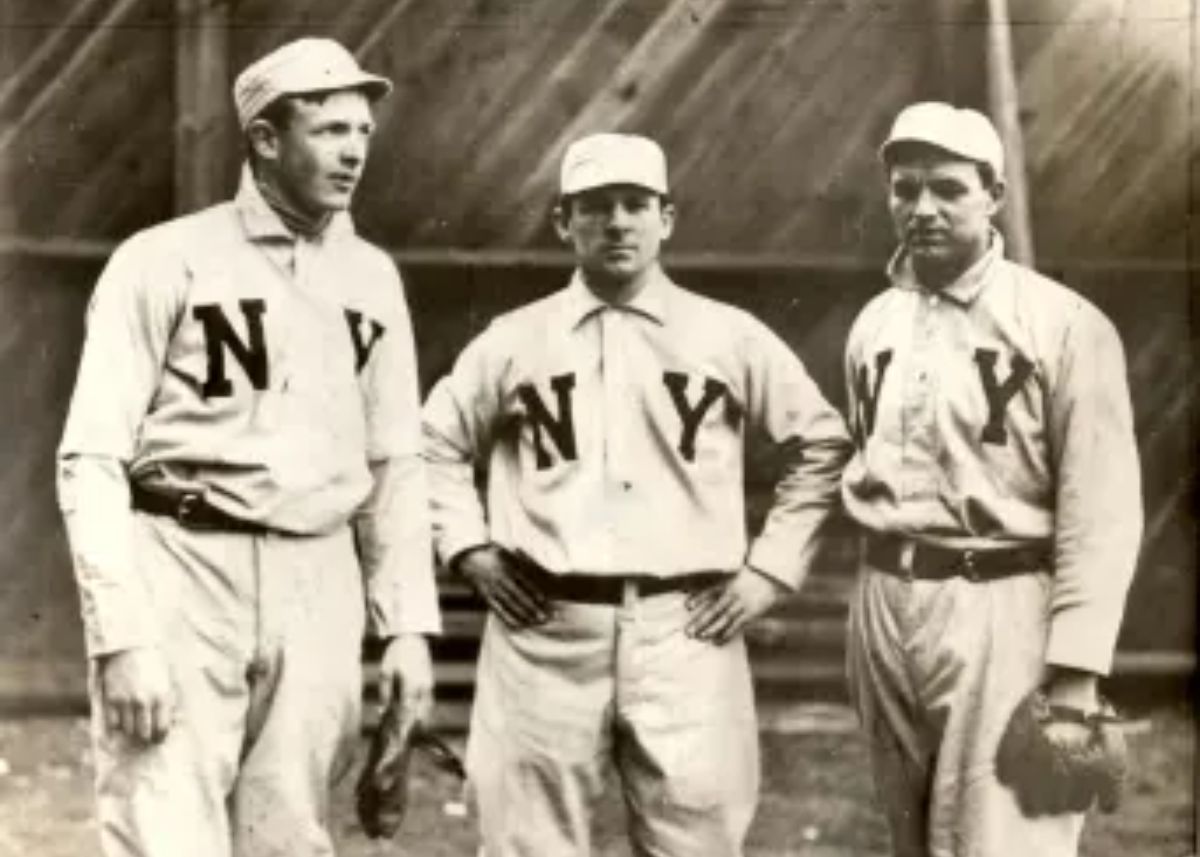
Here it is: the worst season in Yankees history.
The 1912 New York Highlanders, the last season before they were officially christened as the New York Yankees, were a complete, irredeemable disaster both on and off the field. The .329 winning percentage is still the lowest in franchise history.
Let’s start with the team’s ineptitude on the field: the Highlanders scored only 630 runs (the second fewest in the league) while allowing 842 (the most in the league). The team’s non-pitchers in the lineup collectively slashed .262/.334/.339 for a .673 OPS and 88 OPS+. The team’s ERA of 4.13 was by far the worst in the American League, and was especially bad considering this was during the dead-ball era. They had four pitchers lose 10 or more games, with Russ Ford and Jack Warhop losing 21 and 19, respectively (with surprisingly decent ERAs of 3.55 and 2.86, respectively). It also didn’t help that the team’s best hitter, Birdie Cree, who had a breakout season in 1911 (hitting .348 with 22 triples, 48 stolen bases, a 148 wRC+, and 5.7 fWAR and 5.5 bWAR), played in only 50 games due to injuries. Overall, the team’s position players submitted a total bWAR of 4.4, while the pitchers combined for a 13.0 bWAR.
Don’t forget fielding, either. The 1912 Highlanders were as inept as the Bad News Bears in the field, committing a whopping 384 errors and submitted an atrocious .940 fielding percentage, both the worst in the American League and in franchise history. The team’s -9.5 dWAR on Baseball Reference was 7.0 worse than the second worst in the AL. Because of the horrific defense behind them, Highlander pitchers allowed a staggering 230 unearned runs.
Needless to say, the team on the field was a disaster. But off the field, the team was also on shaky ground due to a myriad of problems.
The original owners of the team, Tammany Hall politicians Frank Farrell and William Devery, were absolutely incompetent. They barely had any money to put into improving the team because they gambled it all away. By the end of their ownership, the team carried debts of $20,000.
Even worse, the Highlanders’ “best player” and team captain in 1912 was first baseman Hal Chase, a man who made the eight Chicago Black Sox look like saints. Author Jim Reisler, in his 2005 book Before They Were the Bombers: The New York Yankees’ Early Years, 1903–1915, called Chase “the most crooked player to ever play the game”. This was because Chase was notorious for gambling on his own games, and was more than willing to deliberately throw games he played in. If his .274/.299/.372 slash line, 92 wRC+, 0.1 bWAR, and 32 errors (despite being considered one of the best defensive players of his era) are any indication, while taking into account that he was demoted as player-manager in favor of Harry Wolverton, he was absolutely throwing games for the 1912 Highlanders. And he was the team captain.
With a completely inept roster, ownership with gambling issues, and a team captain who threw games, the wretched showing shouldn’t be a surprise. The Highlanders lost their first six games of the season and ended April at 2-10. From June 15 to July 10, New York went 2-24 with two seven-game losing streaks and an eight-game losing streak. With a 48-84 record entering September 12, the Highlanders went 1-18 in their next 19 games before winning their final game of the season.
The end result was the most recent 100-loss season in club history, a franchise-low .329 winning percentage, and a franchise-worst 55 games out of first. They went 31-44 at home in Hilltop Park (their final season there before moving to the Polo Grounds) and just 19-58 on the road. The 2023 team, while undeniably frustrating to watch, was never this awful.
In fact, the 2023 team wasn’t nearly as bad as any of the five teams on this list, let alone the 1912 team. Hal Steinbrenner and Brian Cashman may be far from perfect and are even directly responsible for many of the team’s current problems, but imagine how bad the Yankees would be if they had Farrell and Devery running the team instead of Steinbrenner and Cashman, and if Chase was team captain instead of Aaron Judge.
Ultimately, after researching and analyzing the worst days of the Bronx Bombers, I’ve come to appreciate what the Yankees currently have. At 24 years old, the Yankees have never had a losing season in my lifetime, let alone field a team as bad as these five.
The 2023 Yankees were undoubtedly a failure. But hopefully, with the right player acquisitions and personnel decisions, the good times could return in 2024.
What do you think? Leave your comment below.
- Categories: 1908 yankees, 1912 yankees, 1925 yankees, 1966 yankees, 1990 yankees, New York Yankees
- Tags: 1908 yankees, 1912 yankees, 1925 yankees, 1966 yankees, 1990 yankees, New York Yankees


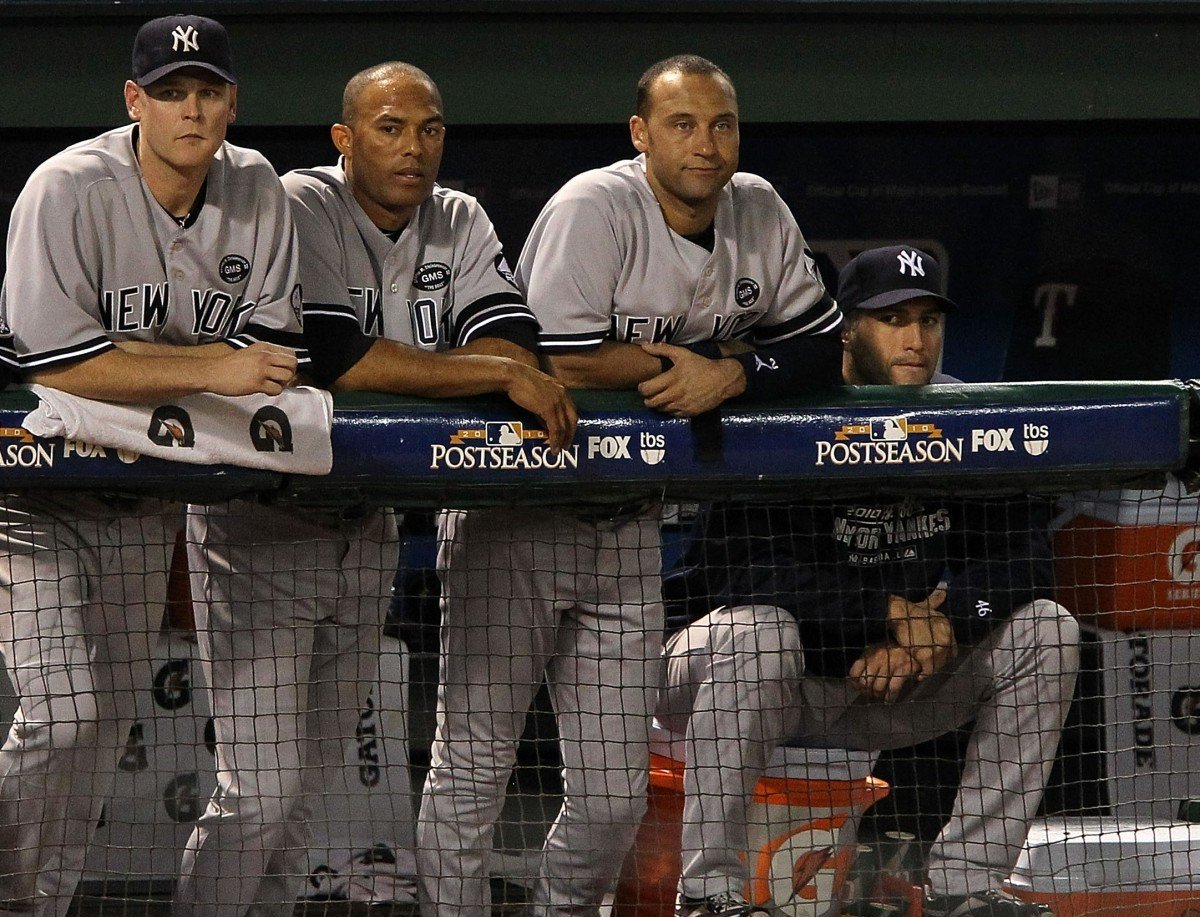
 Follow Us
Follow Us